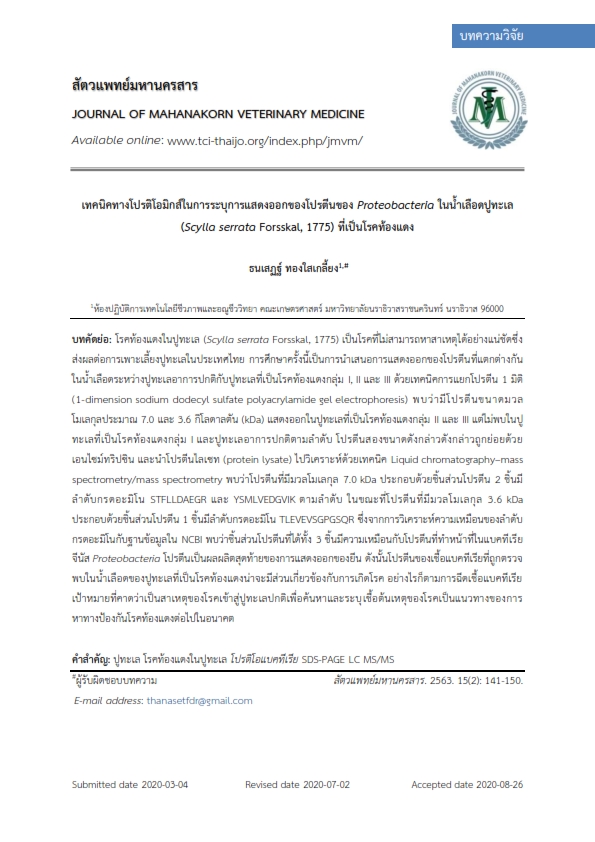Proteomic Technique Identification of Differentially Expressed Proteins of Proteobacteria in Red Sternum Syndrome Mud Crab (Scylla serrata Forsskal, 1775) Hemolymph
Main Article Content
Abstract
Red sternum syndrome mud crab (Scylla serrata Forsskal, 1775) is a poorly understood cause affecting mud crab aquaculture in Thailand. This study presented the differential protein expression in hemolymph between normal mud crab and red sternum syndrome mud crab group I, II and III using 1-dimension sodium dodecyl sulfate polyacrylamide gel electrophoresis. The proteins with size approximately 7.0 and 3.6 kDa were presented in red sternum syndrome mud crab group II and III but were absent in red sternum syndrome mud crab group I and normal mud crab, respectively. The proteins were digested with trypsin and protein lysate were further analyzed by Liquid chromatography–mass spectrometry/mass spectrometry techniques. The results showed 2 protein fragments of 7.0 kDa was consisted of the following amino acid sequences; STFLLDAEGR and YSMLVEDGVIK, respectively. The 3.6 kDa included of only 1 protein fragment, TLEVEVSGPGSQR. The similarity analysis of amino acid sequence with NCBI database, showed all 3 protein fragments were similar to proteins of genus Proteobacteria. Protein is the end product of gene expression. Therefore, bacterial proteins were detected in hemolymph of red sternum syndrome mud crab may likely to be involved in the disease. However, injecting the target bacteria that are expected to cause of disease into normal crab in order to find and identify cause of the disease. Is a way to prevent red sternum syndrome mud crab in the future.
Article Details
References
Areekijseree, M., T. Chuen-Im, and B. Panyarachun. 2010. Characterization of red sternum syndrome in mud crab farms from Thailand. Biologia. 65(1): 150-156.
Boettcher, K. J., K. K. Geaghan, A. P. Maloy, and B. J. Barber. 2005. Roseovarius crassostreae sp. nov., a member of the Roseobacter clade and the apparent cause of juvenile oyster disease (JOD) in cultured Eastern oysters. Int. J. Syst. Evol. Microbiol. 55: 1531–1537.
Bradford, M. M. 1967. A rapid and sensitive method for the quantitation of microgram quantities of protein utilizing the principle of protein-dye binding. Anal. Biochem. 72: 248-254.
Eddy, F., A. Powell, S. Gregory, L. M. Nunan, D. V. Lightner, P. J. Dyson, A. F. Rowley, and R. J. Shields. 2007. A novel bacterial disease of the European shore crab, Carcinus maenas–molecular pathology and epidemiology. Microbiology. 153: 2839-2849.
Fu, L., T. Gao, H. Jiang, F. Qiang, Y. Zhang, and J. Pan. 2019. Staphylococcus aureus causes hepatopancreas browned disease and hepatopancreatic necrosis complications in Chinese mitten crab, Eriocheir sinensis. Aquac. Int. 27: 1301–1314.
Getchell, R. G. 1989. Bacterial shell disease in crustaceans: a review. J. Shellfish Res. 8: 1-6.
Laemmli, U.K. 1970. Cleavage of structural proteins during the larvae of the head of bacteriophage T. Nature. 227: 680-685.
Maloy, A. P., S. E. Ford, R. C. Karney, and K. J. Boettcher. 2007. Roseovarius crassostreae, the etiological agent of Juvenile Oyster Disease (now to be known as Roseovarius Oyster Disease) in Crassostrea virginica. Aquaculture. 269: 71–83.
Meyers, T.R., T.M. Koeneman, C. Botelho, and S. Short. 1987. Bitter crab disease: a fetal dinoflagellate infection and marketing problem for Alaska tanner crabs Chionoecetes bairdi. Dis. Aquat.Organ. 3: 195-126.
Rameshthangam, P. and P. Ramasamy. 2005. Protein expression in white spot syndrome virus infected Penaeus monodon fabricius. Virus Res. 110(1–2): 133-141.
Salaenoi, J., A. Sangcharoen, A. Thongpan, and M. Mingmuang. 2006. Morphology and Haemolymph composition changes in red sternum mud crab (Scylla serrata). Kasetsart J. (Nat. Sci.). 40: 158-166.
Shields, J. D. and C. M. Squyars. 2000. Mortality and hematology of blue crabs, Callinectes sapidus, experimentally infected with the parasitic dinoflagellate Hematodinium perezi. Fish. Bull. 98: 139-152.
Stentiford, G. D., M. Green, K. Baterman, H. J. Small, D. M. Nail, and S. W. Feist. 2002. Infection by a Hematodinium-like parasitic dinoflagellate causes Pink Crab Disease (PCD) in the edible crab Cancer pagurus. J. Invertebr. Pathol. 37: 201-209.
Stewart, J. E. 1993. Infectious disease of marine crustaceans, pp. 319-342. In J. A. Couch and J. W. Fournie, eds. Pathobiology of Marine and Estuarine Organism. CRC Press, Boca Raton, Florida.
Tongsaikling, T., J. Salaenoi, and M. Mingkwan. 2013. Ca2+ATPase, carbonic anhydrase and alkaline phosphatase activities in red sternum mud crabs (Scylla serrata). Kasetsart J. (Nat. Sci.). 47: 252–260.
Wang, H. C., H. C. Wang, G. H. Kou, C. F. Lo, and W. P. Huang. 2007. Identification of icp11, the most highly expressed gene of shrimp white spot syndrome virus (WSSV). Dis. Aquat. Organ. 74: 179–189.


